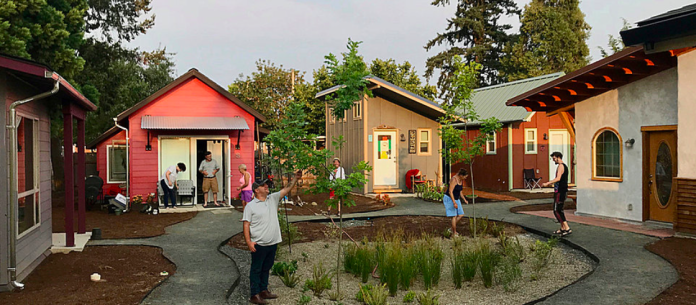
In Seattle’s decades-long quest to solve its homelessness crisis, leaders have learned a harsh lesson: building out shelter capacity and supportive housing isn’t easy and outpacing the rate of people becoming unhoused is incredibly difficult. Building permanent supportive housing (PSH) is both vital to addressing the needs of homeless people and slow. Meanwhile, shelters fill up, sweeps of tent encampments relocate people like chess pieces, and more and more neighbors take up residence in tents and vehicles.
The Seattle region should add another complementary approach that we can put into practice quickly to fill in the gaps in our continuum of care for unhoused neighbors. Managed mobile villages featuring clusters of tiny homes, RV spaces, or modular pods with shared amenities that can rotate between eligible locations is just the thing.
This isn’t fantasy. We already possess legal framework and the operators.
Back in 2020, the Seattle City Council expanded “transitional encampments” citywide by removing most zoning controls, allowing renewals in perpetuity, and authorizing up to 40 sanctioned sites. That gives Seattle unusual flexibility to test well-governed, time-limited villages that move as building timelines, school-year requirements, or neighborhood planning shift.
We already have proof that non-congregate shelters with on-site services function well. In 2024, 46% of people exiting City-funded tiny house programs ended up in permanent housing, according to the City, and just 4% returned to homelessness in six months well above the national average shelter program placement rate.
That’s not a magic bullet; it’s an on-ramp that can be measured out of street homelessness when PSH is lined up. And the City is doubling down on it: this fall, more than 100 additional small houses will open in two new LIHI villages funded in the 2025 budget. Sharon Lee, Executive Director of the Low Income Housing Institute, told The Urbanist that their mission goes beyond shelter.
“These two new tiny house villages will serve hundreds of people in the years to come,” Lee said. “We are thrilled to find vacant land and aim to establish these villages as quickly as possible. Our goal is to help vulnerable individuals transition from cold, wet tents into heated tiny houses this winter.”

But any proposal will have to deal with the politics.
Local not-in-my-backyard (NIMBY) backlash has scuttled sites even recently, when a village of small houses was postponed after some neighbors pushed back. And even inside the system, not everyone believes in the tiny home model: the County’s Lived Experience Coalition and former King County Regional Homelessness Authority (KCRHA) CEO Marc Dones have been opponents of tiny house villages as destinations for long-term stays, citing the risk of warehousing people rather than uplifting them and meeting their long-term needs.
Those criticisms have some merit. Done poorly, tiny home villages run the risk of turning shoddy temporary housing into a permanent fixture lowering expectations for living conditions. The guardrail is design and management: strict service standards, resident decision-making, strong standards for habitability, and an expectation (not a firm limit) that stays are intentional and time-limited, with clear, supported pathways that help residents transition into permanent housing, not just stay sheltered.
So what does a Seattle “village on wheels” look like? Think tiny ensembles of heated, secure cabins or modular pods combined with a small number of RV pads, all staffed 24/7, with hygiene, storage, laundry, mail, and case management.
The “mobile” element is not random shuffling of people; it’s pre-screened rotation among a compact group of screened city parcels, faith-held parcels, and empty lots so providers can stand up shelter near service nodes, transit, and building jobs without adding long-term land strife.
Portland’s Safe Rest Villages create a working model for dignified, managed outdoor shelter with services; its Multnomah site runs 100 units of on-site case management and behavioral health. Commissioner Dan Ryan, who helped launch the program, explained the deeper goal behind it.
“Taking someone who has been chronically houseless,” Ryan said, “we really need to build trust on the streets and help them build that resilience so that when they are permanently housed, they’ll have a much higher success rate.”
Eugene’s Opportunity Village illustrates how resident self-governance and micro-units can stabilize people and speed up transitions. Seattle can implement both, using its own operators and data standards.
Why make tiny homes mobile?
Mobile tiny home villages bring three distinct advantages.
First off, velocity. Mobile tiny home villages can open villages in months, not years. PSH is still the goal, but too frequently it comes at the cost of high per-door capital and lengthy delivery; by comparison, City analyses (and even KCRHA memos) note that small houses have some of the lowest initial costs on the order of tens of thousands per unit for the building and site work precisely because they’re simple, code-compliant shelters in a service-dense village.
Secondly, it’s a good fit for vehicle residents. A growing proportion of unsheltered Seattle’s population is living in cars or RVs; rotating sites with RV lots and safe-parking strategies enable us to get people into the service system without making them surrender the only item of ownership they possess. Federal guidance and West Coast pilots show that these programs work when they are well-implemented and linked with housing navigation.
Third, the temporary model helps defuse local pushback. Neighbors must have a sense of what’s next, and the temporary location model helps set expectations: 9–18 months with a plan for up-close review neighbors and businesses observe a transparent playbook (security, sanitation, trash removal, good-neighbor agreements) and a brief time horizon. That could reduce political backlash that have made tiny house villages a delay and litigation magnet.
Costs and tradeoffs
Seattle and King County must keep expanding PSH, including Health Through Housing conversions of hotels. But we need to be truthful about timelines and unit economics. County reporting puts average cost of capital for Health Through Housing purchase and rehab in the hundreds of thousands per unit, with ongoing annual operating costs still faster and often less expensive than ground-up PSH, but not immediately.

Villages, by design, are lower-capital and build faster; they’re not apartments, and we shouldn’t pretend they are, but they can get people alive, inside, and plugged in to the pipeline of support that comes along. The proper question is not which one model to pick,but rather how to sequence and patch together a variety of models: get people into good non-congregate shelter space today; move them into PSH as it comes online.
What of the “long stays” criticism? It is understandable to worry when shelter and supportive housing capacity is tight. The answer is not to disassemble villages; the answer is to organize them as front doors to housing, and not as cul-de-sacs.
Seattle should publish monthly, provider-level data exits to permanent housing, median time to exit, returns to homelessness so that the public can be informed whether supportive services are working or not. The City is already seeing benefits for small houses; let’s lock that transparency in for all properties and make ongoing operation depend on open performance measures.
Turning this idea into action will take a careful rollout plan. To speed up the timeline to open up villages, the City could pre-permit a village network with clear rules for operations. A framework for the program could look something like this:
- Pre-clear 10–12 locations ahead of time under the 2020 authority with environmental, utility, and transportation screenings done ahead of time.
- Publish a rotation calendar 12 months ahead of time;
- Provide complimentary moving/storage support for residents, during each relocation so the “mobility” expense should be allocated to operators, not the residents themselves.
- Establish a re-deployable, modular kit. Standardize cabins/pods, office units, hygiene trailers, and security lighting so they can be relocated in days, not weeks, to minimize neighborhood disruption and resident stress.
- Implement good-neighbor policies. Incorporate daily trash collection, needle picking up, lighting, and one point of access for businesses and neighboring residents and post turnaround times.
- Stand up wraparound services on-site.
Portland’s Safe Rest Villages offer a proven model for dignified, managed outdoor shelter with wraparound services. While these sites are primarily semi-permanent rather than mobile, their structure of non-congregate pods, 24/7 staffing, case management, and behavioral health on-site demonstrates what well-governed, service-rich villages can achieve.
Eugene’s Opportunity Village adds another layer, showing how resident self-governance and micro-units can stabilize people and accelerate transitions. Seattle can borrow from both models, adapting them into a mobile, flexible network using our existing operators and data standards.
Tiny house villages should also be right-sized to context. In high-density near-transit districts, prioritize cabins/pods and limit RV pads; in industrial areas, introduce managed RV stalls with hookups, gray-water disposal, and car repair partners, alongside safe-parking best practices, which include resident governance and grievance channels. Seattle could borrow from Eugene’s Opportunity Village playbook: resident councils, posted community rules, and open grievance processes reduce conflict and increase safety. )
Finally, let’s talk about the fear behind so much resistance: scale.
Mobile villages are not “the solution.” They’re a bridge that scales — a way of humanizing street-to-home journeys as we add PSH, ramp up rent subsidies, and mend the back door with eviction prevention.
Seattle already is leading the charge with the addition of two more City-funded villages and existing programs have shown tiny homes with higher-than-average permanent-housing exits.
Rather than going back and retreading the previous war over tiny home villages, we can design a next-generation, transparent, outcome-driven solution that is responsible to the community and responsive enough to meet the need where it actually exists.
The issue is not mobile villages versus permanent housing. The issue is waiting until we have the perfect solution versus building a humane, tested stepping stone that gets people inside today, with a clear path to stay there.

Taiwo Adepetun
Taiwo Adepetun is a journalist based in Chicago who covers urban development, housing policy, and social equity. Her work explores how cities can balance growth with community needs, highlighting innovative solutions and the voices of people often left out of the conversation.

